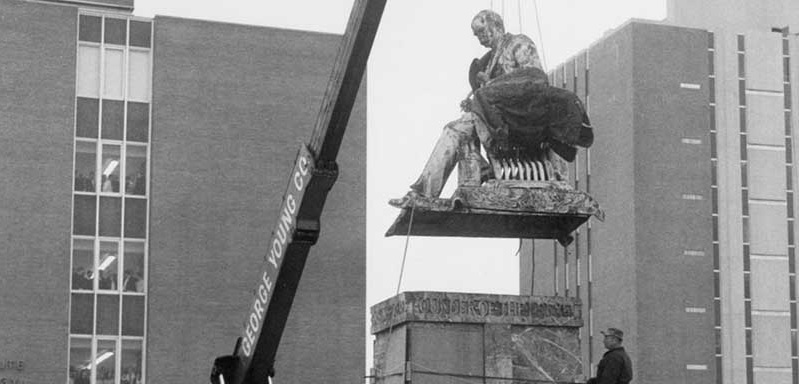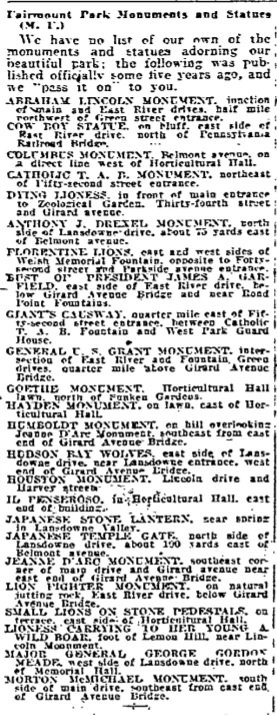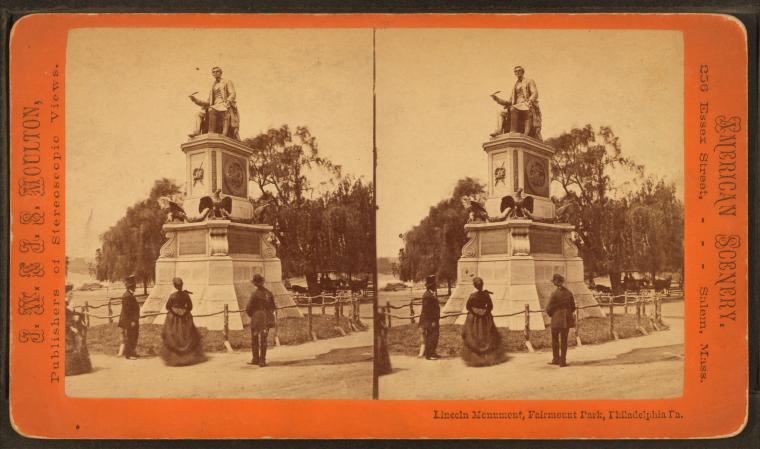In the last few years, Americans have had a lot of conversations about monuments. I've heard people on buses and in restaurants trying to tease apart the legacies of statues--intended to last forever--which honor bad causes and the men who supported them.
One thing that rarely comes into these discussions is that statues and monuments don't last forever. They get worn away by the elements or the hands of pilgrims who have to rub their lucky toe. They also get moved.

The statue of Anthony Drexel being moved in 1984. Photo from Drexel University Archives
So let's check in on some of the statues and monuments that were in Fairmount Park in 1918. The Philadelphia Inquirer was kind enough to provide a list (which is very heavy on lions) on May 12, 1918:

That image is a little hard to read, so here I've transcribed it:
- ABRAHAM LINCOLN MONUMENT
- COW BOY STATUE
- COLUMBUS MONUMENT
- CATHOLIC T. A. B. MONUMENT
- DYING LIONESS
- ANTHONY J. DREXEL MONUMENT
- FLORENTINE LIONS
- BUST OF PRESIDENT JAMES A. GARFIELD
- GIANT'S CAUSEWAY
- GENERAL U. S. GRANT MONUMENT
- GOETHE MONUMENT
- HAYDEN MONUMENT
- HUMBOLDT MONUMENT
- HUDSON BAY WOLVES
- HOUSTON MONUMENT
- IL PENSEROSO
- JAPANESE STONE LANTERN
- JAPANESE TEMPLE GATE
- JEANNE D'ARC MONUMENT
- LION FIGHTER MONUMENT
- SMALL LIONS ON STONE PEDESTALS
- LIONESS CARRYING TO HER YOUNG A WILD BOAR
- MAJOR GENERAL GEORGE GORDON MEADE
- MORTON McMICHAEL MONUMENT
Here's where some of those statues are NOW
Lincoln Monument
This one is still where it was in 1918, but also is a super well documented statue. A search of the Digital Public Library of America returns a lot of results, many of them stereoscopes from the 19th century. Our own archive here at Temple University has a photo of the monument defaced in 1965.

Stereoscopic photo of the Lincoln Monument in Fairmount Park from The Miriam and Ira D. Wallach Division of Art, Prints and Photographs: Photography Collection, The New York Public Library.
Christopher Columbus Monument
The statue of Christopher Columbus that once stood in Fairmount Park was moved to Marconi Plaza in 1982.

Image from Christopher Columbus and His Monument Columbia by John Marcus Dickey
Anthony Drexel Statue
This one has been moved multiple times, moving from Fairmount Park to the campus of Drexel University and then shifting around on campus several times. There's a very detailed write-up of these moves by a Drexel archivist, and even cooler, a animated video showing the plan for the sculpture's most recent move:
For these statues and some other attractions of Fairmount Park, check out the StoryMap I made based on the WPA walking tour of West Fairmount Park from 1937.
100% of the SBD rewards from this #explore1918 post will support the Philadelphia History Initiative @phillyhistory. This crypto-experiment conducted by graduate courses at Temple University's Center for Public History and MLA Program, is exploring history and empowering education. Click here to learn more.
Considering the heft and cost of each one, it's VERY interesting to consider how much monumental movement there has been over the last - how long? When was the first statue moved?
What I'd like to see is an interpretive timeline of movement. Far more than anyone realizes, I'm guessing. Kind of puts a dent in the metaphor/cliche "carved in stone."
Some, maybe all, will be discussed in Penny Bach's book, Public Art in Philadelphia. (Temple Press, 1992).
Downvoting a post can decrease pending rewards and make it less visible. Common reasons:
Submit
Wow, thank you for sharing that 1965 picture of the Lincoln monument.
You're right that the history of statues being moved, removed, or destroyed is an important consideration in ongoing discussions of statues. Thanks for reminding us of this precedent.
Downvoting a post can decrease pending rewards and make it less visible. Common reasons:
Submit
It's interesting to think about how monuments have been perceived over time. For instance, in Ancient Egypt, tearing down or defacing a monument was akin to destroying the very existence of the person depicted, even after death--it would deprive them of an afterlife altogether. It was absolutely the worst thing you could do to someone. Monuments are really important to a culture. What do we choose to memorialize and carry with us through the generations, and why?
Downvoting a post can decrease pending rewards and make it less visible. Common reasons:
Submit